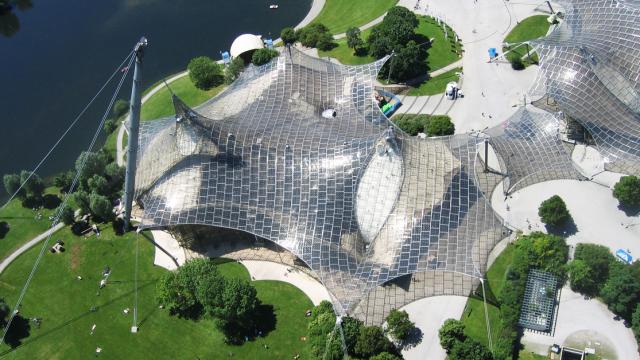Frei Otto, architect behind some of the most important structures and engineering ideas of the last century, has died just two weeks before he was to receive the Pritzker Prize — the award that people often describe as the Nobel Prize for architecture.
Maybe you’ve never heard of Otto. That’s OK. He kept himself outside the fray of crazy-famous architects that defines the 1990s and 2000s. But without him, many of the structures and buildings of the past 50 years wouldn’t exist. Because Otto wasn’t just an architect — he was also a brilliant inventor and engineer who pioneered some of the most far-fetched feats of structural engineering ever completed.
The 1967 International and Universal Exposition or Expo 67, 1967, Montreal, Canada. Photos © Atelier Frei Otto Warmbronn.
Otto was obsessed with tensile structures — think the roof of a tent, where a piece of fabric hangs between two points in tension, versus a cabin, where the beams are in compression instead. And his obsession came from a very literal experience with tent-like shelters: As a soldier during the second World War, he spent two years as a prisoner of war in France where he built all manner of structures with anything he could find laying around, as The New York Times recounts today. Though he had been apprenticed as a stone mason before the war, he came out of the experience possessed by the idea of building with less.
You could trace his whole career back to those two years spend in captivity — the next five decades were spent trying to build the best spaces with as little as possible, as the Pritzker jury described today. That often meant using lightweight, inexpensive plastics or plexiglass strung between complex hardware frameworks to create huge, light-filled volumes that could be easily assembled and disassembled.
Hall at the International Garden Exhibition, 1963, Hamburg, Germany. Entrance Arch at the Federal Garden Exhibition, 1957, Cologne, Germany. Photo © Atelier Frei Otto Warmbronn
Bubbles. The wings of insects, bats, and birds. Spider webs. Trees. Otto’s research into experimental structural engineering — often based on nature — was just as important as his buildings, especially since many of his buildings were temporary.
MIT published two volumes of it in the 1960s, packed with ideas about how tensile strength could be utilized in architecture, from membranes to pneumatics, each of which are now classics. His ideas about inexpensive, light-footprint buildings made him a hero to the progressive designers and inventors of the 1960s and 70s; the Whole Earth Catalogue even published examples of his work.
The most famous example of this — the one you’ll see a lot today — is his roof for the Munich Olympic Park for the Summer Olympics in 1972.
Top two photos © Atelier Frei Otto Warmbronn; Bottom photo via nils gore.
But the ghosts of the Third Reich influenced his work in other ways too. As the Pritzker Jury alludes to:
His architecture would always be a reaction to the heavy, columned buildings constructed for a supposed eternity under the Third Reich in Germany. Otto’s work, in contrast, was lightweight, open to nature, democratic, low-cost, and sometimes even temporary.
It’s a thread you can find running through all of his work — a direct reaction to the presumptuous idea that any building is forever, or that architecture is a tool for doing harm.
Aviary in the Munich Zoo at Hellabrunn, 1979-1980, Munich (Hellabrunn), Germany. Photo © Atelier Frei Otto Warmbronn
Impermanence has definitely been the case with Otto’s work. In some cases, photos are all that remain. But you can find his influence everywhere: From the NFL stadiums to Google, whose newly-announced complex is webbed with tensile netting that’s directly inspired by Otto’s work.
But in a 2005 interview with Icon Eye, he left young architects with a little advice about the difference between what you can build and what you should build:
“Maybe you know that I was a close friend of Bucky Fuller, and we debated the idea of large domes. But why should we build very large spaces when they are not necessary? We can build houses which are two or three kilometres high and we can design halls spanning several kilometres and covering a whole city but we have to ask what does it really make? What does society really need?”
So, yes — the work passes away, as do the architects. But the ideas stick around, and in some cases, take on lives of their own. You can read more about Otto over on the Pritzker site, and check out more images below.
Japan Pavilion, Expo 2000 Hannover, 2000, Hannover, Germany. Photo by Hiroyuki Hirai.
Roof for the Multihalle (multi-purpose hall) in Mannheim, 1970 — 1975, Mannheim, Germany. Photos © Atelier Frei Otto Warmbronn
Institute for Lightweight Structures, interior, 1967, University of Stuttgart in Vaihingen. Photo © Atelier Frei Otto Warmbronn
Diplomatic Club, 1980, Riyadh, Saudi Arabia. Photo © Atelier Frei Otto Warmbronn.
